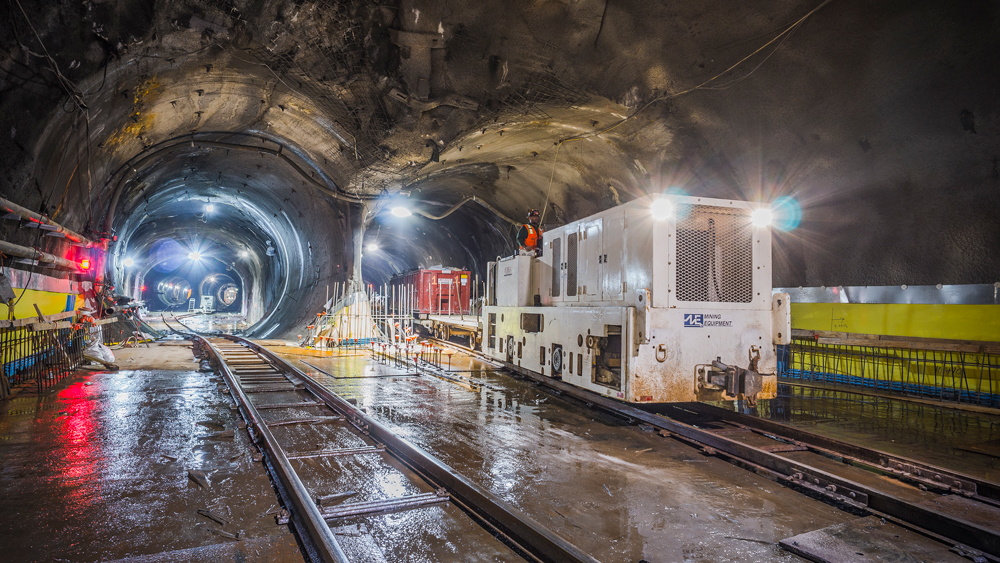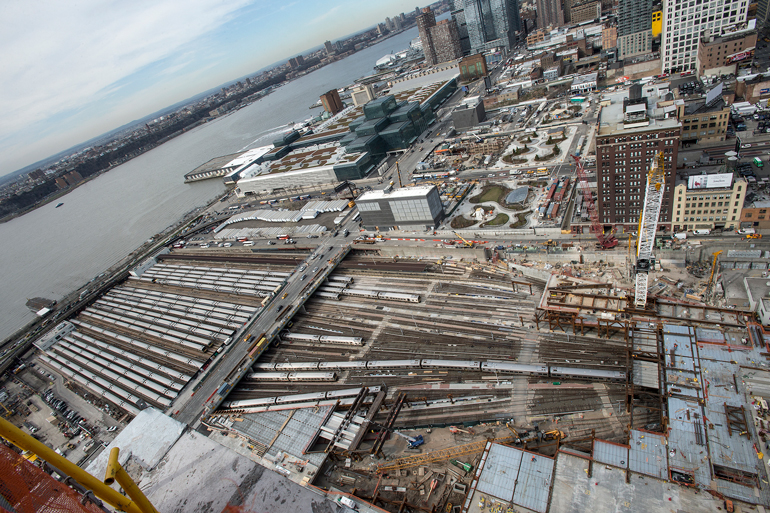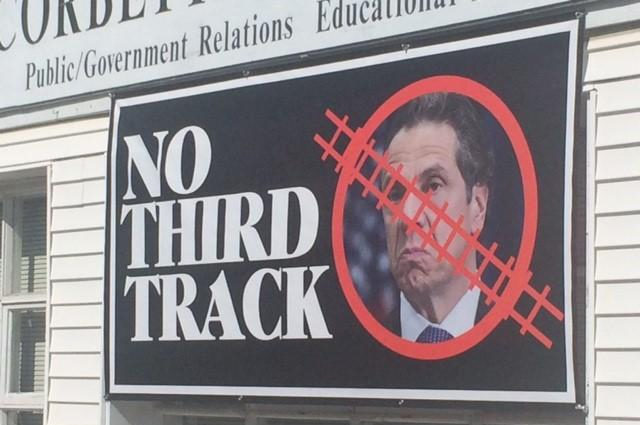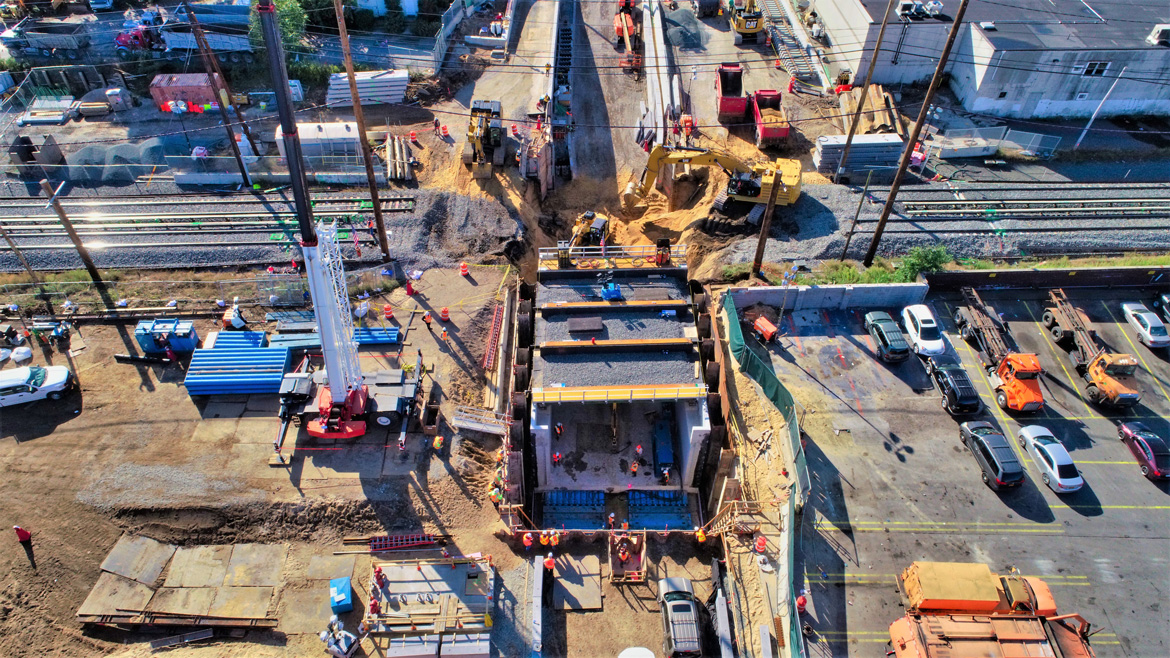
We are celebrating 15 years — and counting — of stories that are deeply researched and deeply felt, that build a historical record of what the city has been.
We are celebrating 15 years — and counting — of stories that are deeply researched and deeply felt, that build a historical record of what the city has been.
Where does New York City end and Long Island begin? To be clear, we’re not looking to spark contentious debates about the Queens-Nassau border. Culturally, the boundary between the city and its most storied suburbs is not as clear cut as either New Yorkers or Long Islanders might like to admit. Stretching from the bustle of Penn Station to the beaches of Montauk, the Long Island Rail Road has borne witness to — and often spurred — the political, economic, and demographic shifts that have reshaped the physical and conceptual boundaries of Brooklyn, Queens, Nassau and Suffolk again and again. As transit infrastructure, and rail in particular, are back in the policy spotlight after a year of record-low use, the Long Island Rail Road may once again be at the center of a major regional reconfiguration. Multibillion dollar investments promise to dramatically increase the system’s capacity at a moment when long-term questions remain about how and where people across the metropolitan region live and work. Below, Elizabeth Moore takes a close look back at the volatile ups and downs of the Rail Road’s ridership over the last century, finding similar entanglements of infrastructure and culture — how sense of place, and one’s place, is shaped by how we get there and back.
Walt Whitman imagined Long Island as a fish; for Robert Moses, it was a whale, with its head at the Narrows and its tail flukes in the Atlantic Ocean. For territorial reasons, New York State insists Long Island isn’t an island at all, but a peninsula; the U.S. Supreme Court agrees. But in truth, ever since most people stopped getting around by boat, Long Island has operated like an increasingly crowded railroad apartment: Suffolk County residents can’t go anywhere without traveling west through Nassau County. And from Nassau, the only way out is through Queens.
The Long Island Rail Road’s tracks connect Manhattan physically with an island that was sundered politically when Brooklyn and the western half of Queens became part of New York City in 1898. Its barrier beaches and terminal glacial moraines are still there, but ever since the consolidation, Long Island’s name has inspired double vision. Long Island is most commonly understood to refer to Nassau and Suffolk counties — but the majority of New York City’s residents live on it.
This conflicted identity has persisted over the century since the opening of Penn Station, during which the Long Island Rail Road (LIRR) became the nation’s busiest commuter railroad, even as it struggled to function as both local urban transit and long-distance railroad. Currently, the MTA is plowing toward completion of two of its most expensive megaprojects ever to benefit that system: East Side Access ($12 billion and counting), with new LIRR tunnels ending near Grand Central Terminal, and a complementary, $2.6 billion “Third Track” on the LIRR’s Main Line just over the Queens border. Together, these projects are expected to boost the number of LIRR trains that can enter Manhattan at rush hour by 50 percent. That, in turn, will allow a major rearrangement of Greater New York’s rush hour, with a domino effect on commuters in Brooklyn and Queens, as well as the Bronx, Westchester, and New Jersey.
Though the impact of COVID-19 on mass transit has been “orders of magnitude worse than a purge during the Great Depression,” as MTA Chairman Pat Foye put it in December, East Side Access and the “Third Track” are premised on dramatic growth in ridership in the decades to come: In 2019, the LIRR hit what the MTA called a “modern record” of 91 million paying passengers. You have to do some digging, though, to understand exactly what that means. The MTA doesn’t keep records going back before 1949, the year that the railroad (then privately-held) declared bankruptcy. But public reports filed with the Interstate Commerce Commission show that in 1929, at a time when Nassau or Suffolk were largely home to farms, coastal villages, and playgrounds for the wealthy, the “premodern” LIRR had 30 percent more riders than it would see in 2019. A second surge, during World War II, also far surpassed recent ridership.
How to make sense of numbers like these? LIRR officials dismiss them as meaningless. Long Island was completely different in those days, they say, and so was the railroad. To be sure, the chart is little use as a performance metric for the agency in 2021. But decoding the perplexing last century of ridership, like reading the rings of an old tree, casts light on the development of both the railroad and Long Island’s identity. Home to part of New York City, legally distinct from it, and sometimes in conflict with it — it’s a relationship of mutual dependency and not a little mutual distaste. The LIRR is dwarfed by NYC Transit in budget and ridership, but it was once indispensable to the city’s intra-urban travel, and still has the potential to both serve transit-hungry neighborhoods in Brooklyn and Queens, and to connect millions of riders with the wider tri-state region.
In 1900, the Pennsylvania Railroad, once the world’s largest corporation, bought a majority stake in the LIRR, primarily so that it could secure the right to cross the Hudson River into New York City and construct its monumental Beaux-Arts train terminal in the nation’s leading commercial city. But the four tunnels it financed under the East River created a commuting railroad that would long outlast Penn Station and the Pennsylvania Railroad itself. The “Pennsy” and its shareholders poured their wealth into a variety of schemes aimed at boosting and profiting from the LIRR, including model farms in Suffolk County, a deep-water port in Montauk and residential development all along its lines. There were still few cars or highways, so travelers to Long Island’s popular coastal resorts generally reached them by train. For most New Yorkers, Long Island was a fresh-air playground. [1]
But the biggest area of growth was closer to Manhattan. With the opening of Penn Station, the LIRR offered a one-seat ride to midtown Manhattan from places like Forest Hills, Kew Gardens, and Flushing — housing and commuters followed. It was a rapidly shifting environment for both passengers and freight, with trams and streetcars making way for new subways and the automobile. In those early years, passengers could ride the LIRR to Whitestone in Queens, to Bushwick, Bay Ridge, or even Manhattan Beach, the fading 19th century summer resort next door to Brighton Beach. The LIRR had also consolidated three once-competing lines to the Rockaways into its busiest service, carrying riders from Penn Station and Flatbush Avenue to that barrier beach and its summer bungalows, restaurants, and amusements. On a summer weekend in the 1930s, the Rockaways could draw a million visitors.[2]
For the Pennsylvania Railroad, the short-hop city riders crowding into its trains were a burden: It spent millions to separate its tracks from busy streets, and to add more trains to serve the booming demand for commuter service. But the passengers cost far more to serve than they delivered in revenue, and the state repeatedly rebuffed LIRR requests for fare increases. Ridership peaked in 1929, at 119 million. That year, Robert Moses opened the first section of the Southern State Parkway.
The stock market crash of 1929 and the Great Depression that followed emptied trains across the country. Meanwhile, the Independent Subway System line to Queens opened in 1936 and 1937, offering service to Manhattan for a nickel.[3] A railroad consultant later calculated that this nickel ride cost the LIRR 60 percent of all its commuters in one stroke. It also made the LIRR much less relevant in the lives of city residents, according to transit historian Andrew Sparberg. The Whitestone branch had already closed in 1932; the Bushwick and Bay Ridge branches carried only freight after 1924. In 1939, pushing to eliminate its street-level crossings in the city and to provide express service, the railroad moved a section of the Atlantic Avenue branch into a tunnel, overriding loud commuter protests as it abandoned seven stations in Brooklyn and Queens.
The Grand Central Parkway and Triborough Bridge opened in 1936. Bus services proliferated in western Nassau and eastern Queens, connecting commuters to that nickel subway ride. By 1940, the LIRR was losing $2 million a year, but the state refused to allow it to raise ticket prices. Then, World War II brought both gas rationing and war production, driving riders and freight back onto trains. 1946 was the year of the LIRR’s second great peak: 115 million riders. But that surge did not last. These postwar riders were increasingly true suburban commuters, traveling longer distances to work than they had in the 1920s.
In 1947, construction began on Levittown: the era of mass suburbanization had begun. Between 1940 and 1970, nearly 1.9 million “non-Hispanic” whites left the city; during the same period, the white population of Nassau and Suffolk counties grew by 1.8 million. Racial covenants, redlining, and discriminatory federal programs were in place everywhere, but the contrast was especially stark here: by 1970, minority groups would account for just 5.3 percent of Nassau-Suffolk’s population, while making up 37 percent of the population of New York City. Meanwhile, in the immediate postwar period, the political cohesion of New York City’s five boroughs seems to have finally severed the psychological link connecting residents of Brooklyn and Queens with the land mass on which they were located. In 1951, the 130-year-old Jamaica, Queens-based Long Island Daily Press betrayed its anxiety when it asked Robert Moses for an op-ed on what constituted “Long Island.” He replied that it was an “indivisible entity” comprising Kings, Queens, Nassau, and Suffolk and about a third of the state’s population.
“Every school child knows this,” the planner scoffed.
But the Long Island Association — a business roundtable originally based at Penn Station and representing Brooklyn, Queens, Nassau, and Suffolk — had already redefined itself by then, parting ways with its urban members and moving its headquarters to Nassau County in 1949. E.B. White’s 1949 essay “Here is New York” laid bare the hardening cultural divergence. Commuters were “the queerest bird of all,” who made New York “the city that is devoured by locusts each day and spat out each night.” To White, the commuter seemed scarcely human: “The suburb he inhabits has no essential vitality of its own and is a mere roost where he comes at day’s end to go to sleep … His entrances and exits are more devious than those in a prairie dog village; and he calmly plays bridge while buried in the mud at the bottom of the East River.”[4]
1949 was also the year the LIRR declared bankruptcy. The railroad was placed under the management of court-appointed trustees. Then, 1950 brought a string of catastrophes: A head-on crash in Rockville Center killed 32; a fire wrecked the Jamaica Bay trestle serving the Rockaways; and on Thanksgiving, a rear-end collision at Richmond Hill, Queens killed 79 people. Every level of government, up to now enthralled by Robert Moses’ highway program, suddenly snapped to attention on the neglected state of the railroad. Decrepit trains and equipment, demoralized and surly trainmen, chronic delays: critics had charged the Pennsylvania Railroad with squeezing its subsidiary LIRR to benefit its own balance sheet, but the onetime Leviathan was already headed for extinction.
15 years of limbo followed, with federal investigations of the wreck, local city and state study commissions, the creation of a temporary special railroad development corporation with tax exemptions, supplemental funding, and fare increases to keep the commuter service running. The LIRR’s Rockaways Branch was transferred to the transit system, becoming part of the A train. The populations of Nassau and Suffolk doubled in the 1950s, but LIRR ridership went the other way, a slide that would not bottom out until the early 1970s. By then, the five-day work week had long since become the norm, and shorter work weeks meant fewer rides on the LIRR.
Robert Caro, in The Power Broker, detailed the fiscal outrage. Moses, chairman of the Triborough Bridge and Tunnel Authority, presided over toll revenues and borrowing power that allowed him to pour $755 million into new bridges and highways during a period when the railroad was expected to rehabilitate itself on a subsidy of $65 million. The Northern State Parkway was completed in 1952, the Long Island Expressway’s first segment in 1958, and the Throgs Neck Bridge in 1961. Not a penny would Moses spare for the LIRR, which had become a national joke by this time, “the kind of train that, if smaller, would make your little boy cry if he found it under his Christmas tree,” as one journalist put it.[5]
All the traffic Moses unleashed, in turn stirred a new love for transit. The LIRR couldn’t be allowed to fail, a committee of advisors to Governor Nelson Rockefeller concluded in 1965 — the Long Island Expressway would have to add 26 lanes to handle all the commuters it carried. That prompted Rockefeller to buy the railroad and form what would become the Metropolitan Transportation Authority. The MTA’s new chairman, William Ronan, unveiled a vast “Program for Action” that included East Side Access, starting work on new tunnels that were to carry LIRR commuters to Grand Central Terminal. He ordered 620 new electric cars, promising to halve commuting times (technical problems with them led to even worse delays for a time). Rockefeller promised LIRR riders “the finest service in the country,” but New York City Mayor John Lindsay used that claim as a laugh line on the Merv Griffin Show. Even comedian Henny Youngman milked it: Man collapses on the Lynbrook train platform. Priest giving last rites asks if he thinks he is going to Heaven. Man replies: “Father, I don’t give a damn where I go, as long as I don’t have to change at Jamaica.”[6]
After a 50-day strike by the LIRR’s twelve unions in 1973, ridership was the lowest it had been since 1918. The MTA got the new cars running, more or less; still, the best thing going for the railroad in the 1970s was what was happening on the highways. The Long Island Expressway had become known as the World’s Longest Parking Lot. The city’s fiscal woes halted the East River tunnel work, but the energy crisis of 1979 drove another spurt of riders back to the railroad. It wasn’t until MTA chairman Richard Ravitch found the money to quintuple the railroad’s capital spending that work began to bring it into a state of good repair, and tackle big projects, like the train storage yard that opened in 1987 beneath what is now Hudson Yards, greatly increasing the rush-hour capacity of the East River tunnels.
The LIRR had long since become a collection of bottlenecks: The tunnels under the East River were only the most obvious one. More troubling, the “Main Line” — the LIRR’s original 1844 right-of-way running down the flat, empty center of Long Island — had always had the best potential to handle express traffic, but the railroad had never gotten around to installing more than two tracks in Nassau before World War II; only a single track ran through the heart of Suffolk. The farm fields around Nassau’s Main Line, meanwhile, had filled up with businesses and subdivisions occupied by suburbanites zealously protective of their property rights. When the LIRR tried to elevate a section of the Queens Line from Floral Park to Hicksville onto a viaduct, in order to fix a series of dangerous crossings and add a third track, residents said no. Decade after decade, despite a series of fatal, grade-crossing accidents, residents persuaded their elected officials to block the work whenever funding was found for it. It reminded them too much of the city. “They said, ‘We don’t want an El! We came here to get away from the El!’” a Mineola village attorney recalled.
As a result, the nation’s busiest commuter line can only carry passengers in one direction on its main line for most of the rush hour. For New York City’s work force, this may have been one of the most important barriers to seeking work in a region whose nonwhite population had already been functionally segregated into a small number of communities.
Nassau County’s population peaked at 1.4 million in 1970, but suburban growth kept rolling eastward. In 2000, Suffolk County’s population overtook Nassau’s; by then the LIRR’s limitations had become intolerable to its business community. Meanwhile, the region’s demographic peril was becoming apparent. The one-way commute was isolating the Long Island economy by putting most New York City workers out of reach; the region was lagging in job creation. It was aging, too: losing its own young workers at almost five times the national rate. Those young people, driven out by an absence of jobs and homes they could afford, were migrating west, sometimes to the very same neighborhoods their grandparents had abandoned.
Under pressure from labor and business officials, as well as transit advocates, the LIRR rolled out another attempt at a third track in 2005, only to be overwhelmed once again by thousands of emotional opponents, including booing Little Leaguers convinced they would lose their playing fields. The plan was politically dead — except that there was no alternative. Ten years later, the nonprofit Rauch Foundation, the Long Island Association, and the New York State Laborers’ Union convinced a broad cross-section of executives and public officials that the region’s economic survival depended on their stepping up to the microphone at those public hearings. Their coalition grew to represent a majority of the region’s 2.8 million residents. In 2016 Governor Andrew Cuomo agreed to lead the effort, and after intensive negotiations and an eye-popping $800 million in concessions to villages along the Main Line, he prevailed on the legislature to approve the $2.6 billion project. The work started in 2018.
Then came COVID-19. After hitting its “modern record” of 91 million in 2019, LIRR ridership plummeted to just 31 million, the lowest recorded in any year since Penn Station opened. Yet, the third track construction continues on schedule. The political importance of the LIRR was plain in March 2021, when the railroad cut service to stem its red ink — only to reverse itself a day later after riders complained, and the governor intervened.
East Side Access is expected to position the railroad for dramatic growth and unlock the transit grid with benefits far beyond Long Island. Shifting LIRR riders to Grand Central Terminal opens up room at Penn, while providing easier access to West Side employment for commuters from Westchester and the Bronx. New eastbound trains, made possible by the third track, open the Long Island job market to commuters from the city. But COVID-19’s impact will leave transit ridership “pressured” for the next few years, the MTA’s Foye admits. Fleeing the pandemic, New Yorkers learned to work from home in distant places, including the East End and the suburbs. For the MTA, the burning question is no longer whether, but how this will have changed commuters’ habits for the long term. Monthly passes are just the most obvious casualty. Meanwhile, this spring — in a back-to-the-future move — the MTA is testing a discounted “Atlantic Ticket” to serve New Yorkers in areas with poor subway access, especially in Southeast Queens. This plan encourages the kind of intra-urban ridership that nearly overwhelmed the private LIRR in the 1920s, only this time around, there is no need to turn a profit.
As the agency sorts out its options heading out of the pandemic, the latent potential of the LIRR’s extant, non-commuter urban track network has never been out of focus. In 2018, the city studied ways to resume passenger service from Jamaica to Long Island City. The Bay Ridge branch has long been key to the Cross Harbor Freight Program, a megaproject to cut truck traffic and pollution. The MTA itself is focused on part of an idea pushed by the Regional Plan Association: turning that Bay Ridge-Astoria line into a subway line, which would allow riders to get around the boroughs without having to go through Manhattan.
Other groups seek to steer this potential in different directions. Transit planners from seven states are pitching the $105 billion North Atlantic Rail initiative, which would tunnel under the Long Island Sound, adapting LIRR infrastructure as part of a 100-minute bullet train to Boston. Much more locally, a broad coalition of park advocates wants to convert part of the old Rockaway Beach Branch into the QueensWay, a family-friendly, 3.5-mile “cultural greenway” from Rego Park to Ozone Park. The idea has drawn a stream of civic idealists, explorers, and naturalists to rediscover the derelict right of way.
The city’s two Long Island boroughs are full of other traces of sites where LIRR riders used to board: from Penny Bridge to Cedar Manor, Malba, Dunton, Kouwenhoven and The Raunt — a drop-off spot for Jamaica Bay fishermen with no address or station. The old ticket stubs and timetables are archived by dedicated railroad bloggers, while abandoned platforms are featured in walking tours for the intrepid. Urban archeologists see in these places a palimpsest of bygone New Yorks. Planners imagine New Yorks yet to come. The LIRR continues to shape complicated, shifting senses of place, and of belonging to place, across a region in constant flux.
The author would like to thank Abigail Cain for contributing research in preparation for this article.
Vincent F. Seyfried, The Long Island Railroad: A Comprehensive History, Part 7. (Garden City: Vincent Seyfried, 1975), 15-16; 281-287.
Andrew Sparberg, “Rails to Rockaway: How a 19th Century Steam Railroad Line Became Part of the 20th Century New York City Subway System” (presentation, the 31st Conference New York State History, June 2010, Ithaca, NY, June 3-5, 2010)
Andrew Sparberg, From A Nickel to A Token: The Journey from Board of Transportation to MTA. (New York: Empire State Editions, 2016).
E.B. White, Here is New York. (New York: Curtis, 1949), 18-22
Robert Caro, The Power Broker. (New York: Vintage Books, 1975), 920-958.
Stan Fischler, Long Island Rail Road (MBI Railroad Color History), (Voyageur Press, 2007), 159.
Elizabeth Moore, Breaking Through: How smart partnerships overcame decades of resistance to modernize America’s busiest commuter railroad (Garden City: The Rauch Foundation, 2018), 47-78.
The views expressed here are those of the authors only and do not reflect the position of The Architectural League of New York.






